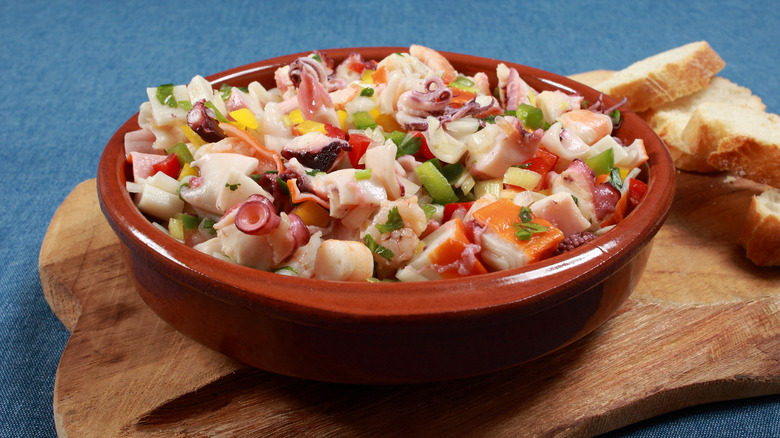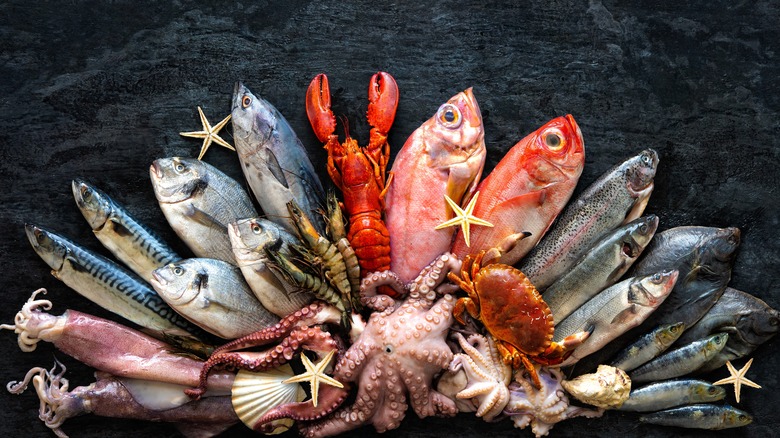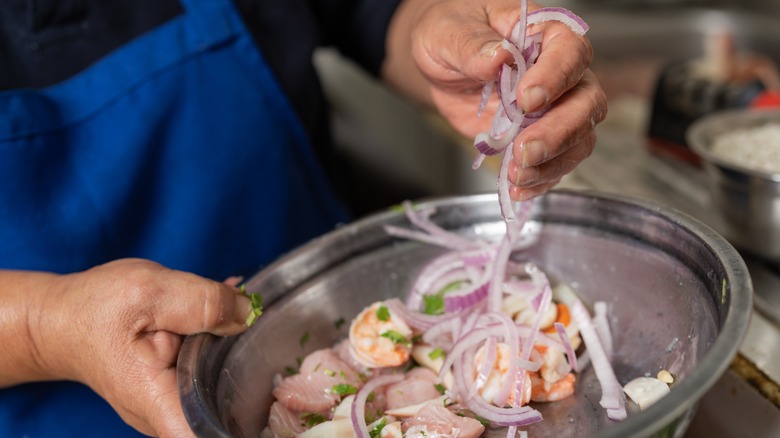The Marinade Step You Shouldn't Skip When Making Ceviche
The elegance of a dish like a ceviche lies in its simplicity. The dish as we know it today is more of a framework than a recipe, it's the product of Peruvian indigenous cuisine incorporating Spanish ingredients and borrowing Japanese food preparation techniques (via New World Review). While it's essentially just raw fish marinated in some sort of acid along with additional aromatics and seasonings, ceviche is defined not by it's ingredients, but by it's the molecular gastronomy techniques. Using fresh fish and ripe produce is essential for a great ceviche, but the most important aspect of the dish is timing.
Because ceviche is made with raw seafood that cures in citric acid, timing is everything. The fish begins changing texture and flavor from the moment it's introduced to the acidic marinade and continues to cure as it sits. According to culinary consultant J. Kenji López-Alt (per Serious Eats), within the first five minutes of marinating, the fish develops distinct "textural changes, with pleasing firmness to the exterior," but is not done quite yet. By 10 minutes, the fish is nearing its ideal texture for great ceviche (the optimal window being 10 to 20 minutes of maceration), but waiting even one hour could result in crumbly, rubbery, over-cured ceviche. To avoid over-curing your ceviche, there's one step in the marinade process that is paramount to managing the chemical time crunch.
Ceviche's crucial marinade step
The approach to preparing ceviche must be methodical in order to minimize spoilage and maximize freshness and flavor. Per HuffPost, culinary educator Frank Proto points out a few things to consider when working with ingredients like raw fish. He suggests using fresh, cold-water ocean fish (like fluke, red snapper, or scallops), making sure all your equipment is clean, and keeping the fish on ice as long as possible. You can assess the quality of your fish from a handful of indicators, according to J. Kenji López-Alt. Its eyes should be clear and bright, gills should be bright red not brown or viscus, the flesh should still have a bit of firmness, and the smell should be briny, but not offensively fishy (via Serious Eats).
After preparing all your ingredients, it comes time to assemble the marinade. This part is crucial because a careful, engaged approach to the marinade will permeate through to the end product. For this reason, Proto insists that you taste your marinade before adding it to the fish "to make sure the flavors are balanced" because once incorporated, the curing clock starts. Of course, you can always add seasonings post-assembly, but those last-minute add-ins may not assimilate at an optimal rate, and the resulting crescendo of flavor may be out of time and tune. But tasting your marinade gives you the power to make adjustments to hone the flavor for a more homogenized and harmonized final dish.
Marinade variations
Ceviche is one of the most popular dishes in Peruvian cuisine, but the concrete origins and etymological roots are a bit hazy. Nearly every cooking culture has some variation of ceviche, but the dish proliferated in Peru to the point where it's a symbol of national and regional identity (per Fine Dining Lovers).
A traditional ceviche recipe is a perfect framework for experimenting with ingredients and flavors. To build your ceviche, start with your seafood; fluke, red snapper, or sea bass are preferred but feel free to experiment with squid, scallops, and shrimp. From there, you can consider what kind of fruit juice might pair well with your seafood. Once you have your two foundational ingredients, seasoning decisions can be guided by working within culinary genres.
A classic Peruvian ceviche marinade consists of a base of fresh lime juice and fish broth seasoned with onion, garlic, cilantro, ginger, and rocoto chili, while an Ecuadorian variation incorporates tomatoes, orange juice, and shrimp (per Wine Mag). They also refer to some recipe variations that use avocado and a blend of orange, lemon, and lime juices for a more Baja flair. In other parts of the Pacific, marinade recipes include coconut milk and alternative fruit juices like pineapple. Though it's exciting to get creative, remember to consistently taste your marinade before adding the fish because doing so will not only help curate your intended taste but to maximize flavor and optimize the texture of the final product.


